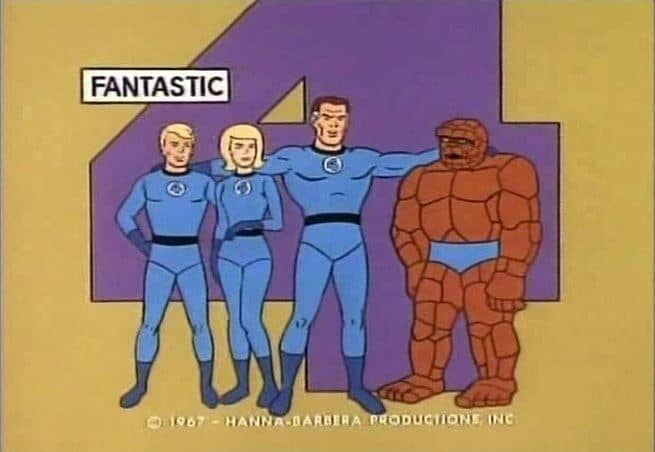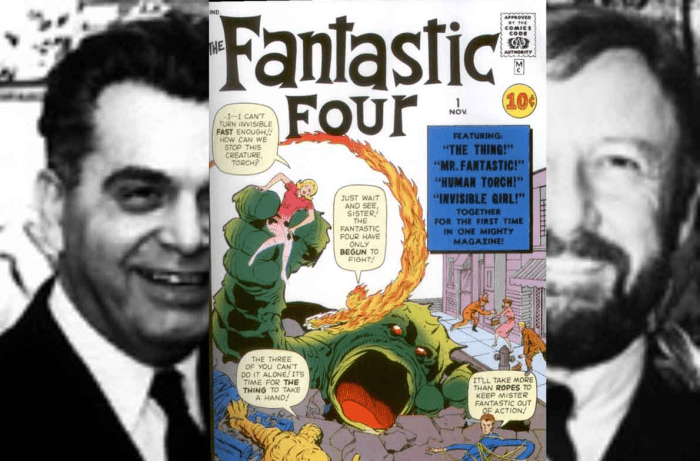Fantastic Four 1967 68 Animated Television Series
I love blitheness and going over the history of iconic animated series.

"Fantastic Four" is Marvel Comics first family of superheroes, brought to life equally an animated series.
1967: The Yr of Superheroes
For Hanna-Barbera, 1967 was a profitable twelvemonth when it came to superhero cartoons. Following the success of Space Ghost & Dino Boy the previous year (and, to a bottom extent, Frankenstein Jr. & the Impossibles), they had six new action/adventure cartoons greenlit for the 1967-68 season across all three networks.
While most of these were original characters or were based on characters in the public domain, one show stood unique among them as being based on a pre-existing superhero squad. Developed for ABC to be paired with the Spider-Man cartoon that would be ambulation that same season, Hanna-Barbera adapted the first family of Marvel: The Fantastic Four.
| Airdates | Network | Studio |
|---|---|---|
| September 9, 1967 - September 21, 1968 | ABC | Hanna-Barbera |

The Fantastic Four were developed by Jack Kirby and Stan Lee, the first of many superheroes they would create together.
The Fantastic 4 (1967)
The Fantastic Four's real life origin, and indeed the origin of the Marvel Universe itself, goes dorsum to six years earlier, in 1961. Sales of superheroes had been down for over a decade following the end of Earth State of war two, just they were on the rise again later on rival publisher National Periodical Publications (later known every bit DC Comics) managed to spark a new interest in them, showtime with the introduction of the Barry Allen version of the Flash (the often cited kickoff of the "Argent Age" of comic books). Past 1961, their newest hit was the Justice League of America, a squad made up of DC's most pop heroes. The newly rebranded Marvel Comics (previously known equally "Timely" in the 40s and "Atlas" in the 50s), led by publisher Martin Goodman, saw how assisting the trend was going, and decided to create their ain superhero team. Goodman enlisted Stan Lee, who had been working at the company since he was a teenager in 1939, as well as Jack Kirby, an artist who had previously worked on the Captain America comics, to develop the new team.
The full general thought from Lee going in was that he felt that the heroes from DC at the time were too perfect, never seeming to display any personal follies and never arguing betwixt each other the way that real people exercise. Using Kirby's earlier DC serial "Challengers of the Unknown" as a ground, the two creators adult a squad of 4 heroes given powers past gamma rays while on a test flight. Heroes who, while operating in cooperation as a family, also quarrelled between each other like a family.
There was the genius scientist Reed Richards, "Mr. Fantastic", authoritative and with the ability to stretch his body in a way like that of Plastic Human being from Quality Comics. His girlfriend, Sue Tempest, "The Invisible Woman", was given her powers because, equally Lee would claim, he was inspired by Universal's "The Invisible Man" and didn't want Sue to be just a copy of Wonder Adult female with super-strength.
Sue's hot-headed brother, Johnny Storm, was accordingly given the ability to turn into burn as "The Human Torch", a reimagining of an earlier Timely Comics hero. And then in that location was Ben Grimm, "The Affair", a hero seeped in tragedy as he had been transformed into a powerful rock-like creature, but being unable to change back, had been robbed of a normal life.
The comic book was a striking with audiences, and boosted Marvel Comics equally a legitimate competitor to DC, with Stan Lee and Jack Kirby continuing to develop numerous iconic heroes throughout the 1960s. 5 years after the Fantastic Four launched, the comic publisher had already made information technology onto boob tube with "The Curiosity Super Heroes", a syndicated cartoon using extremely limited animation to bring Kirby'southward artwork to life. Nevertheless, the Fantastic 4 were non part of this; Instead, the following yr, the honor to animate Marvel's showtime superheroes of the Silver Historic period would befall Hanna-Barbera, who debuted a Fantastic Four animated series in the fall of 1967 on ABC.
Coil to Continue
Read More From Reelrundown
Whether information technology was intentional or only incidental, the decision to wait a yr for Hanna-Barbera to brand the show, rather than accept the team announced on Marvel's syndicated program, worked in their favor. While the syndicated program had such a minimal budget that what little animation it had was primarily used to motion pre-fatigued comic volume art but enough to seem convincing, "Fantastic 4" was completely animated from the footing-up. Utilizing the production pipeline Hanna-Barbera had developed over the by 10 years, every bit well equally redesigns by artist Alex Toth (a frequent correspondent to the studio's superhero shows), the series came out looking arguably ameliorate than any of the other cartoons of the fourth dimension based on comic books.
While not as direct every bit the syndicated programme, Hanna-Barbera's "Fantastic Iv" did see many of the early on memorable storylines go adapted into animated grade. Some of these episodes even shared the same titles as the stories they adapted, such as episode 5b and 7 being the same as issues thirteen and 29 (which featured villain Red Ghost). Through these adaptations, many of their iconic villains appeared, such as Medico Doom, the Mole Human, Super-Skrull, Klaw, and fifty-fifty Blastaar (who had simply fabricated his debut in the comics a few months earlier).

One of the most iconic Fantastic Four storylines, "The Galactus Trilogy", was adapted into an episode.
Fifty-fifty the virtually iconic storyline of the comic'southward showtime five years, "The Galactus Trilogy", was adjusted as an episode. In this appearance, Galactus (voiced by actor Ted Cassidy, who'd get on to play Ben Grimm in the unrelated Fantastic Four cartoon from the 70s) was oddly depicted with green peel. Overall, the episode was a decent attempt at condensing the three result storyline into a 22 infinitesimal format.

Due to the rights being held up with Krantz Films, Prince Namor was substituted with an original character, "Prince Triton".
On the subject area of oddities, it'southward worth noting most the episode "Danger in the Depths". An of import character to the early years of the Fantastic Four was Prince Namor, a character from the Gilt Age of comics who was reintroduced in Fantastic Four as a sometimes-antagonist/sometimes-ally of the grouping. The episode adapted a story in which he had appeared in the comics (outcome #33), however his part was replaced with an original grapheme, "Prince Triton". This was due to the face that Namor had been appearing in the syndicated "Marvel Super Heroes" show in his own segments, disallowment Hanna-Barbera from using him. However, his supporting cast was still immune to announced.
The Fantastic Four cartoon saw the vocalisation talents of actor Gerald Mohr as Reed Richards, extra Jo Ann Pflug as Sue Storm, Jac Flounders every bit Johnny Tempest, and Paul Frees as Ben Grimm and Utau the Watcher. Additional guest voices include Joseph Sirola, Jack DeLeon, Vic Perrin, and Hal Smith.
While popular, the serial just lasted one season (plus a flavour of reruns in 1968), as the rising tide of parental groups against violence on television made the networks gradually shied away from action cartoons. Information technology went on to take a decent run in syndication, nigh notably as office of the "Hanna Barbera'south World of Super Adventure" block in 1978 alongside other series with graphic symbol designs by Alex Toth. Most recently, however, the show has been tied upwards in company rivalry which prevent a home release, as the rights were eventually acquired Warner Bros, rival studio to Disney, who now own Curiosity itself.

In 1979, Hanna-Barbera would brand a series of cartoons about a boy who could transform into the Thing via a magic ring.
For the Showtime Family of Marvel, Hanna-Barbera'due south Fantastic Iv was an important milestone in both proving the characters could be translated into animation well, and that the studio could handle adapting pre-existing superheroes. Hanna-Barbera did somewhat revisit the Fantastic Four again, with a series of shorts starring a boy who could transform into the Thing. Only equally for what they learned in working on the 1967 serial, it would aid them on their adjacent big superhero project the following decade.
This content reflects the personal opinions of the author. Information technology is accurate and true to the best of the writer's knowledge and should not be substituted for impartial fact or advice in legal, political, or personal matters.
Fantastic Four 1967 68 Animated Television Series
Source: https://reelrundown.com/animation/History-of-Hanna-Barbera-Fantastic-Four-1967









Comments
Post a Comment